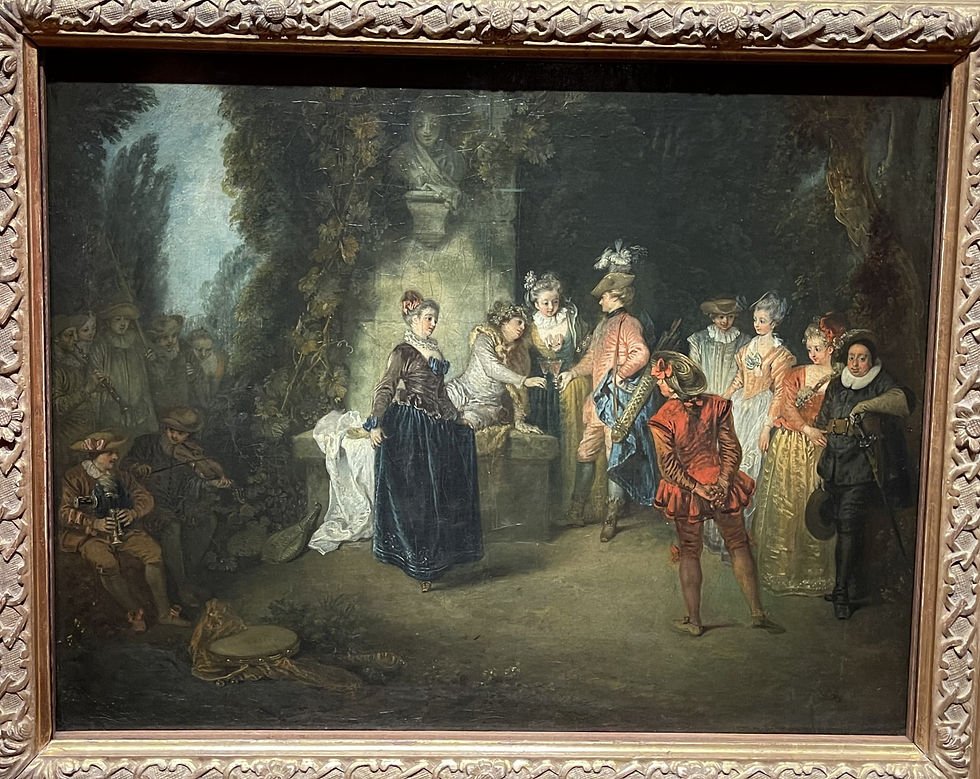Time to return to Cincinnati for another awe-inspiring exhibition at the Cincinnati Museum of Art. Now showing through October 3, 2021, is an exhibition titled 'Paintings, Politics & the Monuments Men'. This exhibition focuses on some of the paintings that were seized and hidden by the Nazis during WWII. It is well known that countless European masterpieces fell victim to Nazi confiscation during Hitler's reign. He attempted not only to ban "degenerate" art but also to acquire Aryanized art, which he intended for his own museum, the Fuhrërmuseum. Nazi policies of 'Aryanization' led to the forced transfer of Jewish-owned paintings, property, and businesses. The Nazis looted from prominent art dealers and collectors throughout Europe, annexing pieces for the Führer's future collection. Many of those confiscated works, in addition to artworks transferred from German museums, were hidden in the deep, dark, dry, and temperate salt mines of Bavaria and Austria. In 1943, an Allied team of art professionals, including museum curators and art historians, was assembled and assigned to a military unit named the 'Monuments Men', to help locate, secure, and safeguard centuries-old European masterpieces. At the war's termination in 1945, US Army units stumbled upon a LARGE repository of paintings, as well as Nazi gold, within the Kaiseroda salt mine at Merkers. Those paintings were sent to the Wiesbaden Central Collection Point (CCP) for cataloging, which was directed by one of the 'Monument's Men.'
Why is an exhibition like this in Cincinnati?
Walter Farmer, a native of Ohio worked as an interior designer in Cincinnati. In 1942 he entered the army as an officer and was initially posted to Normandy to aid in its rebuilding efforts subsequent to D-Day. In 1945, Farmer joined the 'Monuments Men' and was put in charge as the director of the Central Collecting Point (CCP) in Wiesbaden, Germany. That collecting point housed thousands of artworks recovered at the end of the war. It is from that collecting point that the US government ordered 202 German works of art, originally from the Berlin State Museums, to be shipped to Washington DC for 'protective custody.' Despite Farmer's protest of this order, the artworks were sent to Washington. There, they were stored at the National Gallery for a couple of years, after which time a decision was made by President Truman in 1948 to return them to Germany. Before they were returned, however, they were exhibited at the National Gallery, as well as toured throughout thirteen American cities offering a very rare opportunity for Americans to view so many European masterpieces on U.S. soil. The monies raised from the 2.5 million viewers of that "blockbuster" exhibition were donated to organizations aiding relief agencies working with German children.

The Berlin 202
In November 1945, 202 paintings from two Berlin State Museums were shipped to the United States. They included works by some famous masters like Botticelli, Caravaggio, Jan van Eyck, Vermeer, Titian, Rembrandt, Rubens, Montegna, Manet, and Dürer. The variety among the "202" from altarpieces and devotional paintings to portraits, landscapes, and genre paintings was exceptional. Initially stored within the National Gallery in Washington DC, they ultimately went on tour, prior to their return to Germany, escorted by a military convoy and guarded by military police.
While the current Cincinnati exhibition displays several works by various artists who had OTHER paintings of theirs as part of the Berlin 202; the Monuments Men exhibition also showcases four paintings that were ACTUALLY part of the 'Berlin 202'. These four are shown below.
'Ideal Portrait of a Lady' by Sandro Botticelli (Italian)

'The Crucifixion' by Konrad Witz (German)

'Panorama of Holland' by Philips Koninck (Dutch)

'The French Comedians' by Antoine Watteau (French)

Why did Farmer object to the transfer?
Farmer protested the transfer of the art to the US. When he learned of the order, he urgently summoned the Monuments Men to discuss it and they unanimously resisted the transfer, collectively drafting the Wiesbaden Manifesto. The officers opposed the transfer on ETHICAL GROUNDS and felt that the transfer ran counter to the policy of the Allied Forces since the start of the war. The mission of the Monuments Men was to protect and preserve all monuments, documents, and objects of historic, artistic, cultural, or archaeological value. Since the war had ended when this order was declared, they felt that "military necessity" for transfer could not be ethically invoked. Furthermore, they felt that removing a part of the heritage of a nation would create justified bitterness, even if that heritage may be interpreted as "spoils of war."
After the departure of the 'Berlin 202' from Wiesbaden, morale at the CCP was very low. To rebuild goodwill with the German people and to demonstrate the care that the Central Collecting Point was taking with their collections, Farmer organized exhibitions in Wiesbaden displaying works that were still housed in the CCP. One of the most popular objects he placed on view in those exhibitions was the famous bust of the Egyptian queen Nefertiti.
Degenerate Art
Other pieces of art faired less well during the war. Hitler's rise to power in 1933 initiated a systematic suppression of contemporary art throughout Germany. The Nazi regime cast much of 20th-century art as 'un-German' or 'degenerate'. This was a term associated with negative racial, physical, and mental connotations. The art of many prominent Jewish artists of that time, such as works by Kandinsky, Kokoschka, Munch, and Chagall fell into that category. The state museums purged such avant-garde art and the respective artists were expelled from professional societies. The confiscated works were often exhibited by the Nazis in "shame exhibitions", the most famous of which was the Entartete Kunst (Degenerate Art) exhibition held in Munich in 1937. The defamatory exhibits were intended to disparage modern art and to associate the Jewish race with the decline of German art. Many confiscated works were burned or permanently destroyed.
The current Cincinnati exhibition displays several works that were deemed 'Degenerate Art.' Two such examples are paintings by Viennese Oskar Kokoschka and Russian Alexej von Jawlensky, shown below. Several other paintings of theirs were seized, sold, or destroyed.
Restitution of Looted Works
After the war, LOOTED ART was discovered in thousands of locations throughout Europe including castles, monasteries, military bunkers, assorted buildings, and numerous mines. They have been auctioned, sold, and traded in both the public and private markets. Now, three-quarters of a century after the war, there still remain countless 'orphaned' works of art, as well as countless families seeking restitution of their family's lost treasures. Many museums, lawyers, and detectives are actively working to facilitate those reunions. The Musée du Louvre in Paris, for example, has recently opened two galleries dedicated to Nazi-looted art to encourage the heirs of their rightful owners to come forward. These pieces are also catalogued on-line in the section of Musées Nationaux Récupération (MNR).
In essence, Farmer and the Monuments Men sought to re-write the long-held rules of war, where 'to the victor, go the spoils.' They felt that the RESTITUTION of property to their rightful owners was an important aspect of the MORALITY of victory and that upholding and restoring cultural patrimony was worth their fight.
Farmer, a cultured man from Cincinnati, a Monuments Man, and a huge supporter of the Cincinnati Museum of Art, donated much of his personal art collection to the museum upon his death in 1997. The Cincinnati Museum of Art curated this exhibition in commemoration of Farmer's contributions to the city and to the greater art world. In 1996 Farmer was awarded Germany's Federal Cross of Merit in recognition of his work at the CCP in Wiesbaden.




















Comentários